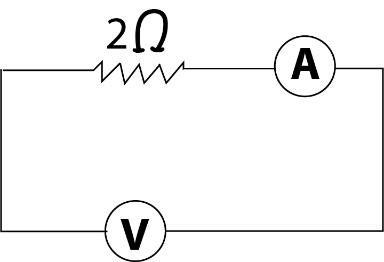
If the voltmeter reads 0.21V and the ammeter reads 0.1A, the resistance of the ammeter is (in ohm)

A) 0.01
B) 0.15
C) 0.2
D) 0.1

Answer
558.3k+ views
Hint
In this question as ammeter and resistance are kept in series so their resistances will add and after that we will apply the ohm’s law i.e. $V = IR$, I is the current and R is the total resistance. On substituting the values, we will get the desired result.
Complete step by step answer
As in the circuit diagram, resistance $2\Omega $ and ammeter is connected in series and we have to calculate the value of the resistance of the ammeter.
For this, let us consider RA is the resistance of the ammeter which we have to calculate.
Now, as the resistance$2\Omega $ and ammeter is connected in series then we can write the total resistance which is the sum of the both the resistances, i.e.
$R = 2\Omega + {R_A}$ ……………………… (1)
Now, as it is given that
Voltage applied across the circuit is $V = 0.21V$
And the current passing through the circuit is $I = 0.1A$
Now, applying the ohm’s law which states that voltage is proportional to the current and the current.
$ \Rightarrow V = IR$
Where R is the total resistance of the circuit
Now put the all values in above equation, we get
$\Rightarrow 0.21 = 0.1 \times \left( {{R_A} + 2} \right) $
$\Rightarrow \dfrac{{0.21}}{{0.1}} = {R_A} + 2 $
$\Rightarrow {R_A} = 2.1 - 2 $
$\Rightarrow {R_A} = 0.1\Omega $
Hence, the resistance of the ammeter is 0.1 ohm.
Thus, option (D) is correct.
Note
It must be notice that when two resistances are connected in the series their resistance increases, it means the total resistance is the sum of all the resistances i.e. $R = {R_1} + {R_2} + {R_3} +. ...........$
But when the resistances are connected in parallel arrangement then their total resistance decreases which can be written as $\dfrac{1}{R} = \dfrac{1}{{{R_1}}} + \dfrac{1}{{{R_2}}} + \dfrac{1}{{{R_3}}} +. ............$
Therefore, care must be taken in calculating the total resistance of the circuit.
In this question as ammeter and resistance are kept in series so their resistances will add and after that we will apply the ohm’s law i.e. $V = IR$, I is the current and R is the total resistance. On substituting the values, we will get the desired result.
Complete step by step answer
As in the circuit diagram, resistance $2\Omega $ and ammeter is connected in series and we have to calculate the value of the resistance of the ammeter.
For this, let us consider RA is the resistance of the ammeter which we have to calculate.
Now, as the resistance$2\Omega $ and ammeter is connected in series then we can write the total resistance which is the sum of the both the resistances, i.e.
$R = 2\Omega + {R_A}$ ……………………… (1)
Now, as it is given that
Voltage applied across the circuit is $V = 0.21V$
And the current passing through the circuit is $I = 0.1A$
Now, applying the ohm’s law which states that voltage is proportional to the current and the current.
$ \Rightarrow V = IR$
Where R is the total resistance of the circuit
Now put the all values in above equation, we get
$\Rightarrow 0.21 = 0.1 \times \left( {{R_A} + 2} \right) $
$\Rightarrow \dfrac{{0.21}}{{0.1}} = {R_A} + 2 $
$\Rightarrow {R_A} = 2.1 - 2 $
$\Rightarrow {R_A} = 0.1\Omega $
Hence, the resistance of the ammeter is 0.1 ohm.
Thus, option (D) is correct.
Note
It must be notice that when two resistances are connected in the series their resistance increases, it means the total resistance is the sum of all the resistances i.e. $R = {R_1} + {R_2} + {R_3} +. ...........$
But when the resistances are connected in parallel arrangement then their total resistance decreases which can be written as $\dfrac{1}{R} = \dfrac{1}{{{R_1}}} + \dfrac{1}{{{R_2}}} + \dfrac{1}{{{R_3}}} +. ............$
Therefore, care must be taken in calculating the total resistance of the circuit.
Recently Updated Pages
Master Class 12 Business Studies: Engaging Questions & Answers for Success

Master Class 12 Social Science: Engaging Questions & Answers for Success

Master Class 12 English: Engaging Questions & Answers for Success

Master Class 12 Chemistry: Engaging Questions & Answers for Success

Class 12 Question and Answer - Your Ultimate Solutions Guide

Master Class 12 Economics: Engaging Questions & Answers for Success

Trending doubts
What are the major means of transport Explain each class 12 social science CBSE

Which are the Top 10 Largest Countries of the World?

Draw a labelled sketch of the human eye class 12 physics CBSE

How much time does it take to bleed after eating p class 12 biology CBSE

Explain sex determination in humans with line diag class 12 biology CBSE

When was the first election held in India a 194748 class 12 sst CBSE




